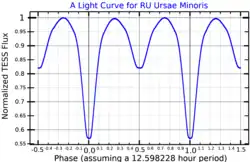| Observation data Epoch J2000 Equinox J2000 | |
|---|---|
| Constellation | Ursa Minor |
| Right ascension | 13h 38m 56.8159s[2] |
| Declination | +69° 48′ 11.1694″[2] |
| Apparent magnitude (V) | 10 - 10.66[3] |
| Characteristics | |
| Spectral type | F0 IV/V + K5V |
| Astrometry | |
| Proper motion (μ) | RA: 17.253±0.056[2] mas/yr Dec.: −5.004±0.049[2] mas/yr |
| Parallax (π) | 3.5007 ± 0.0317 mas[2] |
| Distance | 932 ± 8 ly (286 ± 3 pc) |
| Absolute magnitude (MV) | 2.45 ± 0.12 (A) 5.88 ± 0.19 (B)[4] |
| Absolute bolometric magnitude (Mbol) | 2.48 ± 0.12 (A) 5.37 ± 0.19 (B)[4] |
| Orbit[4] | |
| Period (P) | 0.52492555(1) d |
| Semi-major axis (a) | 3.99 ± 0.02 M☉ |
| Inclination (i) | 82.33 ± 0.05° |
| Periastron epoch (T) | JD 2441596.33645(6) |
| Details[4] | |
| RU UMi A | |
| Mass | 2.32 ± 0.07 M☉ |
| Radius | 1.78 ± 0.02 R☉ |
| Luminosity | 7.63 ± 0.87 L☉ |
| Surface gravity (log g) | 4.30 ± 0.02 cgs |
| Temperature | 7200 ± 200 K |
| RU UMi B | |
| Mass | 0.76 ± 0.02 M☉ |
| Radius | 1.14 ± 0.02 R☉ |
| Luminosity | 0.54 ± 0.10 L☉ |
| Surface gravity (log g) | 4.20 ± 0.02 cgs |
| Temperature | 4630 ± 200 K |
| Other designations | |
| Database references | |
| SIMBAD | data |
RU Ursae Minoris is a binary star system in the constellation Ursa Minor. Its apparent magnitude ranges from 10 to 10.66 over 0.52 days as one star passes in front of the other relative to observers on Earth.[3] Its component stars were calculated to be a primary star of spectral type F0IV/V and a secondary of spectral type K5V, both slightly more luminous than their spectral types indicate. The system is semidetached, as the secondary star is filling its Roche lobe and transferring matter to the primary.[6] The primary is between 2.2 and 2.3 times as massive as the Sun, with 1.8 times its radius and around 8 times its luminosity. The secondary has around 0.72 times the Sun's mass, 1.1 times its radius and between 0.58 and 0.86 times its luminosity.[7]
The period the two take to orbit each other is decreasing very slowly (by approximately 0.15 seconds per year), suggesting the components are moving closer and will become a contact binary.[7]
References
- ↑ "MAST: Barbara A. Mikulski Archive for Space Telescopes". Space Telescope Science Institute. Retrieved 8 December 2021.
- 1 2 3 4 5 Brown, A. G. A.; et al. (Gaia collaboration) (August 2018). "Gaia Data Release 2: Summary of the contents and survey properties". Astronomy & Astrophysics. 616. A1. arXiv:1804.09365. Bibcode:2018A&A...616A...1G. doi:10.1051/0004-6361/201833051. Gaia DR2 record for this source at VizieR.
- 1 2 Watson, Christopher (4 January 2010). "RU Ursae Minoris". AAVSO Website. American Association of Variable Star Observers. Retrieved 18 July 2015.
- 1 2 3 4 Lee, Jae Woo; Kim, Chun-Hwey; Kim, Seung-Lee; Lee, Chung-Uk; Han, Wonyong; Koch, Robert H. (2008). "A Long-term Photometric Study of the Near-contact Binary RU Ursae Minoris". Publications of the Astronomical Society of the Pacific. 120 (869): 720. Bibcode:2008PASP..120..720L. doi:10.1086/589976.
- ↑ "RU Ursae Minoris". SIMBAD. Centre de données astronomiques de Strasbourg. Retrieved 2019-10-07.
- ↑ Manimanis, V. N.; Niarchos, P. G. (2001). "A Photometric study of the near-contact system RU Ursae Minoris". Astronomy and Astrophysics. 369 (3): 960–64. Bibcode:2001A&A...369..960M. doi:10.1051/0004-6361:20010178.
- 1 2 Zhu, Li-Ying; Qian, Sheng-Bang; Xiang, Fu-Yuan (2006). "The Near-Contact Binary RU Ursae Minoris". Publications of the Astronomical Society of Japan. 58 (2): 361–66. Bibcode:2006PASJ...58..361Z. doi:10.1093/pasj/58.2.361.
